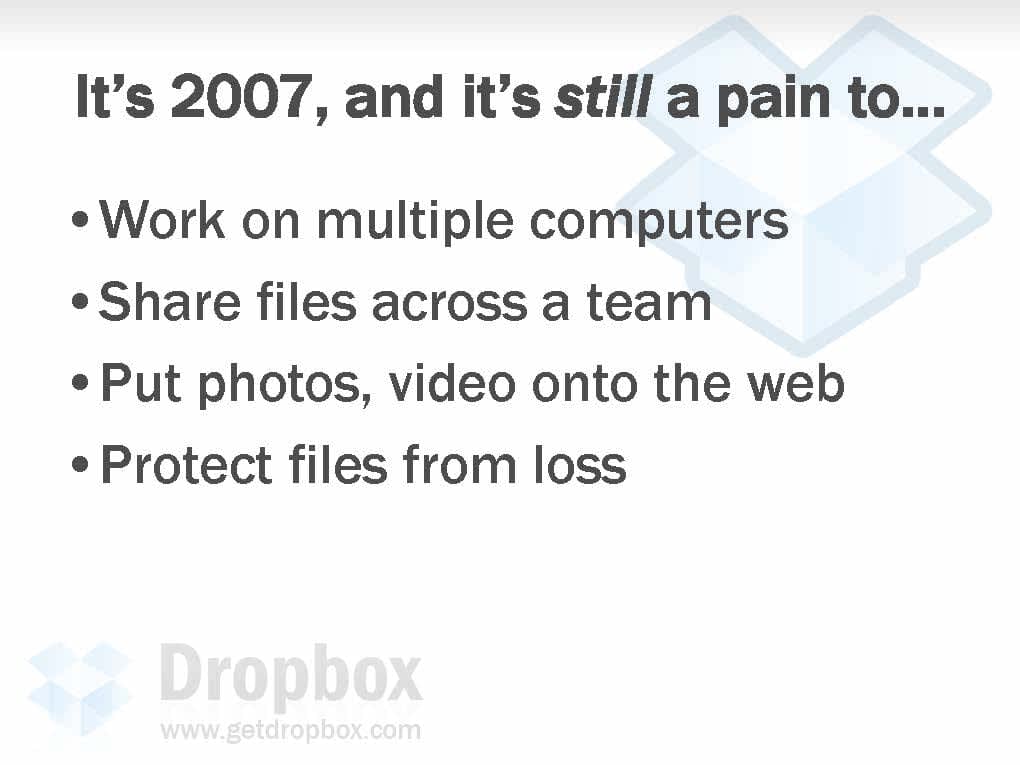A compelling pitch deck is essential for startups raising capital. You only have a few minutes to convey five to seven key points you want investors to remember. A clear and concise pitch deck can make a big difference, helping differentiate your startup from the competition and increasing the odds of fundraising success.
Let's take a look at some essential slides to include in your pitch deck, design best practices to keep in mind, and other resources to help you succeed.
7 Essential Slides
Every startup's pitch deck will be different, but Aaron Harris recommends a few basic slides. These slides help support a narrative that takes investors from a customer's problem to a startup's solution. While pitch decks for seed funding may only contain these essential slides, later fundraising stages may require more slides and other information.
Title Slide
The title slide contains your company's name and a one-line description of what you do. Many tech startups compare themselves to well-known companies, using one-liners like "Netflix for Video Games." As a result, investors instantly understand their goals. But before you take this route, make sure that the comparison is genuinely valid.
Problem Slide
The problem slide should clearly state the problem that your startup is trying to solve. Investors want to ensure that the problem is real and painful for a large target market. Often, a relatable story or customer anecdote is the best way to describe the problem. In addition, you may want to include the total market size to demonstrate its ubiquity.

Dropbox clearly conveys problems that customers have in a way that’s very relatable to the audience. Source: Dropbox / Alexander Jarvis
Solution Slide
The solution slide should explain how your startup solves the problem you just presented in as few words as possible. Like the problem slide, you can use a relatable story to describe how your solution helps customers in more concrete terms. If possible, you can also support these stories with aggregate data points from your existing customers.
Traction Slide
The traction slide should show your startup's traction, focusing on clear and meaningful numbers. If you don't have existing traction (e.g., you haven't launched a product or have uneven growth), you can use this slide to talk about your milestones or upcoming goals over the coming months and how you intend to gain traction.
Business Model Slide
The business model slide should focus on how you make money, the underlying unit economics, and how you plan to scale. In addition, you might reference the competitive landscape and show how your business model differs from other companies in the space. For instance, are you pricing at a premium or to undercut the competition?

Airbnb’s business model slide is very clear and takes investors from market size to revenue projections in three steps. Source: Airbnb / Beautiful AI
Team Slide
Most early-stage investors focus on the team more than the product, making this slide extremely important. Talk about why your team is especially well-suited to solve the problem and the expertise that they bring to the table. If you have a small team, you might also outline some key positions you still need to fill and why they're critical to growth.
Ask Slide
The ask slide should outline how much money you need and where it gets you. In addition, you should lay out where you'll be inside of a year and how you'll move to the subsequent funding round.
Design Best Practices
Many startup founders spend a lot of time on colors, fonts, and other design considerations. While these make some difference, font size, contrast, and other readability concerns are typically more important. At the same time, it's essential to ensure that the slides are immediately understandable and easy for investors to remember.
Kevin Hale suggests focusing on legibility, simplicity, and obviousness to maximize effectiveness.
Legibility
Pitch decks aren't very helpful if nobody can read them, so using a large typeface with simple, bold, and contrasting fonts is essential. If you're presenting to a large room or older investors, you should adjust your font size, charts, and other graphics to ensure everyone can easily read them – otherwise, it's easy for them to tune out.
Simplicity
Each slide should focus on a single idea. If you pack too many ideas into a single slide, it's easy to lose people when explaining it. On the other hand, if you require three slides to explain a concept, people may lose their train of thought between them. The most memorable slides are almost always the simplest ones conveying a single powerful idea.
Obviousness
Slides should be easy to understand at a glance. After all, you have a limited amount of time, and investors are easily distractible. For example, if you have a slide, label the axis and explicitly call out the takeaways (e.g., the percentage growth or MRR). On the other hand, avoid unnecessary text or caveats that can distract from the main point.
Pitch Deck Resources
Creating investor presentations has never been easier. In addition to a growing number of templates, several new platforms make it easier than ever to build attractive presentations.
Some platforms to consider include:
Slidebean – Slidebean offers an easy-to-use app for building pitch decks based on templates from successful venture-backed startups. In addition, they provide consulting services to help with everything from writing to design.
Pitch – Pitch is a collaborative pitch deck design platform, making it easy for remote teams to work together. In addition, the platform offers pitch deck templates, including some for startups.
Beautiful.ai – Beautiful.ai leverages artificial intelligence to help design slides around content in record time. You don't have to worry about lining up arrows or moving around text boxes. And like the other options, they provide numerous templates.
If you want to check out an example of a pitch deck that worked then check out what Uber put together in their early days.
The Bottom Line
Pitch decks are an essential part of the fundraising process. While every startup is different, most share a handful of components to communicate their mission and plan with investors effectively. When designing these slides, startups should ensure that their presentations are legible, simple, and obvious to maximize impact.
If you're building an MVP, Intent can help you become fundraising-ready with a polished product and a data-driven plan. Contact us to discuss your project and learn how we can help!

Greg Cargopoulos
Marketing Lead

